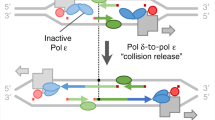Abstract
The nucleotide composition of nuclear DNA has been determined in a cell line (HAB) that has grown for 275 generations with complete substitution of bromodeoxyuridine (BrdU) for thymidine in nuclear DNA. Within 50 generations there is a ∼3% decrease in the G content and an equivalent increase in the BrdU content of DNA, relative to the unsubstituted parent cell line. However, these alterations do not continue to accumulate when the cells are grown for up to 275 generations with fully substituted DNA, suggesting that they are not brought about by BrdU-induced base transitions due to mispairing. RNA transcription has been examined both in vivo and in vitro to determine whether or not BrdU substitution in DNA results in large-scale transcriptional errors. The nucleotide composition of 18S and 28S rRNA from cells 0, 60%, and 100% substituted with BrdU does not significantly differ. Further, when DNA from these cells is transcribed in vitro with E. coli RNA polymerase, there is no evidence for altered incorporation of nucleotides into RNA made from the substituted templates.
Similar content being viewed by others
Literature cited
Freese, E. (1959).J. Mol. Biol. 1:87–105.
Bugg, C.E., Thomas, J.M., Sundaralingam, M., and Rao, S.T. (1971).Biopolymers 10:175–219.
Davidson, R.L., and Bick, M.D. (1973).Proc. Natl. Acad. Sci. U.S.A. 70:138–142.
Bick, M.D., and Davidson, R.L. (1974).Proc. Natl. Acad. Sci. U.S.A. 71:2082–2086.
Hill, B.T., Tsuboi, A., and Baserga, R. (1974).Proc. Natl. Acad. Sci. U.S.A 71:455–459.
Randerath, E., and Randerath, K. (1965).Anal. Biochem. 12:83–93.
Studier, F.W. (1965).J. Mol. Biol. 11:373–390.
Burgess, R.R. (1969).J. Biol. Chem. 244:6160–6167.
Sinclair, J.H., and Brown, D.D. (1971).Biochemistry 10:2761–2769.
Jones, T.C., and Dove, W.F. (1972).J. Mol. Biol. 64:409–416.
Stambrook, P., and Williamson, R. (1974).Eur. J. Biochem. 48:297–302.
Trautner, T.A., Swartz, M.H., and Kornberg, A. (1962).Proc. Natl. Acad. Sci. U.S.A. 48:449–455.
Bick, M.D. (1975).Nucleic Acids Res. 2:1513–1523.
Author information
Authors and Affiliations
Rights and permissions
About this article
Cite this article
Bick, M.D., Davidson, R.L. Nucleotide analysis of DNA and RNA in cells with thymidine totally replaced by bromodeoxyuridine. Somat Cell Mol Genet 2, 63–76 (1976). https://doi.org/10.1007/BF01539243
Received:
Issue Date:
DOI: https://doi.org/10.1007/BF01539243




